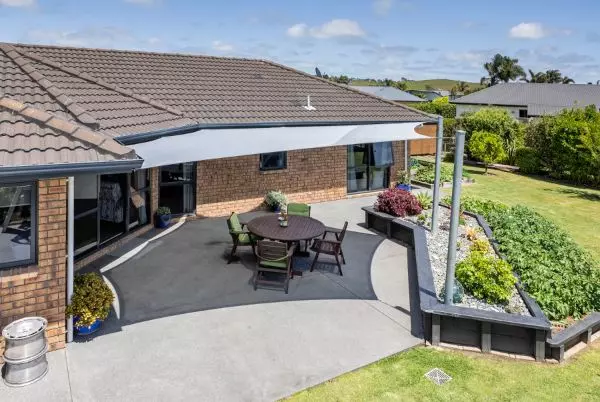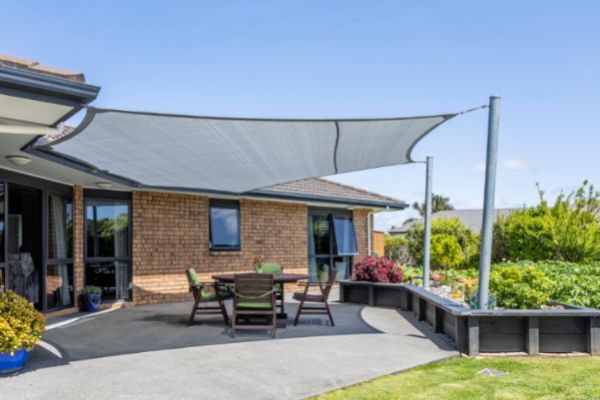Installing Your Shade Sail
What tools and equipment do I need to install my shade sail?
To install a shade sail you will need the following equipment:
- A compass
- Long tape measure
- Ladder
- Drill
- String
- Spirit level
- Wheelbarrow
- Digging equipment
- A strong flat piece of timber
- Underground plans of services including the location of conduits through existing concrete slabs, Wi-Fi cables etc.

The Installation Process
1. Install the supporting posts
The fixing points are the structural foundation of your shade sail and therefore equally, if not more important than the installation of the actual sail. Ideally, your fixing points are supporting posts, however, it is possible to use existing walls or other features to affix to.
Supporting posts
As previously stated, we recommend using steel columns for your supporting posts. These should be galvanised and maybe pre powder coated or painted once installed. You have the choice to use either rectangular, circular, or square steel posts. Our preference is the circular posts as these look more aesthetically appealing.
Size of holes required for supporting posts
The recommended size of supporting posts is dependent on the shade sail dimensions. As a guide, many installers say supporting posts should be installed one third below ground and two thirds above ground.
Ordering the supporting posts
We recommend that you contact your local supplier of galvanised steel and request the quantity and sizes you require along with welded caps. If you are happy with galvanised steel posts it is likely your supplier will be able to deliver the finished product.
If you would prefer to colour match the steel posts to your current outdoor theme you can arrange for the posts to be powder coated or the posts can be painted.

The digging process
To allow for tensioning, the supporting posts need to be inserted in the ground at least 30 centimetres away from the edges of the shade sun sails.
The ground needs to be firm, virgin ground to provide a strong enough environment to hold the supporting posts and subsequent attachment of the sail in place. If this is not possible you will need to dig deeper and wider footings.
If the ground is too firm, you may need to hire an excavator to enable you to dig deep enough for the supporting posts. Equally, if you are installing a large bespoke shade sail you will most likely need to hire an excavator to create a deep enough footing to supports the posts.
BEFORE YOU COMMENCE DIGGING CHECK THAT THERE ARE NO UNDERGROUND PIPES OR CABLES
This includes electric, water, sewage, telephone and electric.
You can check for pipes and cables by reviewing the plans of your property or verifying visually by following the trail of cables and pipes to see if they run close to the area where you will be digging. For further verification, you can employ the services of a utility mapping company.
You may also want to consider what you will do with the soil from the dugout holes (it may not be suitable for the garden due to high clay content). Options include hiring a skip or employing a company to dig the footings, then remove the soil and take it away.
Concrete
Once you have inserted the supporting posts into the holes, they will need to be secured using concrete. A standard hole of a 0.5 metres diameter x 1.2 metres depth will require 0.03 cubic metre of concrete.
The simplest solution is to have readymade concrete delivered. Aside from being hassle-free, the experts will do the calculations in terms of quantity and concentration of the concrete. Even if it is not possible to back the truck right up to the hole, barrowing it from the truck to the hole is usually much easier than mixing the concrete yourself by hand.
If you are ordering ready-made concrete, make sure it has at least 20mpa strength. For that reason, we do not recommend rapid set concrete as it is not normally strong enough.
Angle the supporting post slightly outwards by a just a couple of degrees, once the concrete has been poured in. This is for aesthetic reasons only as otherwise it can look like the posts are tilting inwards once the sail has been attached and tensioned.
It is recommended that the concrete be allowed to set for a minimum of 48 hours before attempting to attach the shade sail to the fixing points. Create a slight slope away from the posts to enable water drainage.
If you have dug the footings for your supporting posts in advance, make sure to cover the holes to ensure they keep dry and are not filled with rain which can impact the drying of the concrete.
Furnishing the supporting posts
Ensure that any fixing accessories on the supporting posts, such as the eye bolt are facing the supporting post diagonally opposite. The eyebolt should be positioned approximately 10 centimetres from the top of the support post.
Inserting and securing the supporting posts
Once the supporting posts have been furnished the support posts are ready to stand in place. Due to the weight of the steel supporting posts ensure you have enough help readily available. Once in place, the concrete can be poured in and it will fit around the supporting posts. We recommend that you do not fill to the top but allow some room for the grass to grow back.
Installing other fitting points
As previously covered, you can use other fitting points such as walls, roof, fascia, pergolas, and buildings. Although supporting posts inserted into footings below ground are the preferred method, as long as the surface is structurally sound, it can be used.
Concrete Slabs
On occasion supporting posts can be bolted into an existing concrete slab. This is not advised as the existing slabs have been installed to bear downward weight not the drawing intensity of a sun shade sail. The probable result is that the concrete would break up or the bolts holding the supporting posts would buckle.
If you still wish to use concrete slabs as the base for your supporting posts, we recommend that you seek advice from an engineer as to its suitability. In this case, you should drill through the existing concrete slab to enable the insertion of the supporting posts.
Walls
You should not assume that a wall will take the tensioning weight of a sun shade sail as walls are also designed to take downward weight. We would recommend employing the services of a building engineer to check the suitability of using your chosen wall as a fitting point for your sun shade sail and that the stonework is sufficiently attached to the frame of your house to avoid any potential structural damage or injuries.
If you still wish to use a wall as a fitting point it is recommended only for use if are installing a small shade sail that you remove during the winter months and when strong winds or snow are forecast when not in use and do not over tension the sun shade sail.
In terms of fitting accessories, we recommend a large wall plate that extends over many bricks and is installed ensuring that there are multiple bricks above the plate. Alternatively, you can use internal and external corner brackets which are suitable for when you are using the corner of a wall as a fitting point. They are considered more secure than wall plates but are still only suitable for small shade sails in protected areas.
On occasion, supporting posts are used on walls as fixing points. We strongly recommend seeking the advice of a structural engineer to certify the wall as suitable for this method as again there could be risk of structural damage and/or injury. If you do choose this method, we advise using fixing accessories at multiple positions on the supporting posts.
Fascias
Whilst, the actual fascia is not solely strong enough on its own to be a fitting point, by putting a wooden beam between two rafters and pushed up tightly against the inside of the fascia which creates a secure and sturdy mounting point for a small sun shade sail. Using a fixing accessory such as an eyebolt attached to the internal rafter with the thread projecting through the fascia can create a strong mounting point.

2. Fit the sun shade sail
If everything prior to fitting the shade sail has been done correctly, this should only take a few hours.
Firstly, remove the shade sun sail from its packaging, not using any equipment that could accidentally cut through the sail. Before laying the sail out on the ground, clear a spot that is free from debris and dust or anything that could cut or dirty the sail. Inspect the sail to ensure the hem is in the correct position.
Position the sail by matching the tag on the sail to its allocated point. If you are using turnbuckles, ensure they are fully extended and lubricated.
How to tension a shade sail
Using a ladder and beginning with the highest fixing posts attach the turnbuckle to the mounting point and then the corner of the sail. Continue this process with the lower posts. For the last post you may need a mechanical intervention to support the movement of the sail to the turnbuckle, as it will likely be tight. With these smaller shadesails you can run a cord between the eyebolt and the ring on the sun shade sail several times, which when pulled will significantly increase your pulling power to get the corner of the sail to the tensioning device. In areas of strong winds, this cable can be left in place in lieu of a turnbuckle as in the event of a storm the sail can be quickly removed. If you plan to do this, you could ensure that the cable is made of a UV protected material.
Do not panic when it does not fit the first time. It will need to be tightened more than you will initially think. We recommend that you first tighten the sail, then stop for the material to rest and stretch into place then tighten it again. You should repeat this process until the material is in place.
Once all the turnbuckles are attached to the shade sail, gently screw them in place alternating between the different corners. When the shade sail is taut in its entirety and the edges are tight, the sun shade sail has been successfully installed. At this point you will just need to lock off the turnbuckle nuts and give the sun shade sail a visual check to ensure everything is in place and secure.
Maintenance of your sun shade sail
The sun shade sail is designed to be low maintenance. However, to ensure longevity and the maximum benefit from your sailshade you should perform the following periodic maintenance tasks:
- Approximately four weeks after the installation of your custom shade sail you should check whether your sail needs further tensioning to ensure the sail remains. Thereafter, we recommend periodic re-tensioning to ensure the cloth remains tight.
- You should check that the fixing points and the turnbuckles are tight and there is no damage to the fitments.
- Over time your custom-made shade sail will become dirty and will need to be cleaned. We recommend that you clean your sun shade sail every 3 to 6 months. You should lay your bespoke sun shade sail on a smooth, clean surface on a dry, sunny day ensuring that the sun shade sail will have sufficient time to fully dry after being cleaned. Avoid chemicals and high-pressure water jets as these will likely damage and/or compromise the level of UVR protection of your bespoke sun shade sail. Instead use a mild detergent and water, a low-pressure water hose and a scrubbing brush. You should also remove any foliage that has dropped onto your custom sail shade at the time, as failure to do so may cause staining or damage.
- We recommend that you take down your custom shade sail during the winter to protect it from the elements. You should ensure your shadesail is dry before being stored and kept away from rodents preferably in a protective container.
If you’re at the start of your shade sail buying process and want to find out how to measure for a shade sail, click here to read our handy guide. Or to find out why you should install a shade, read about the many benefits here.
